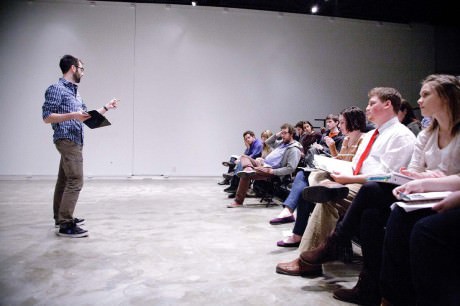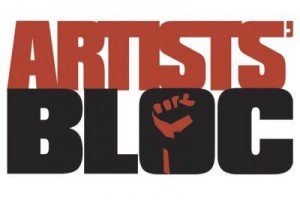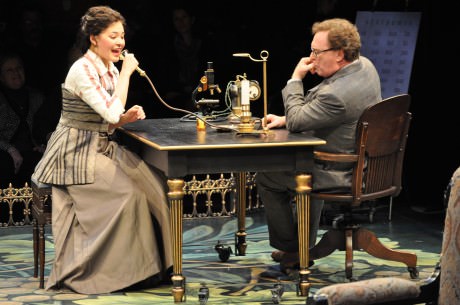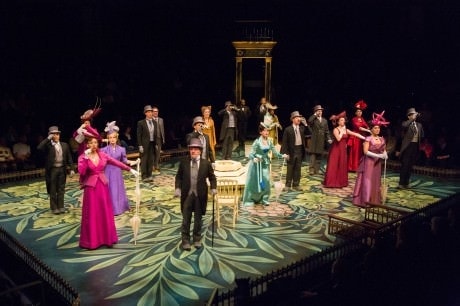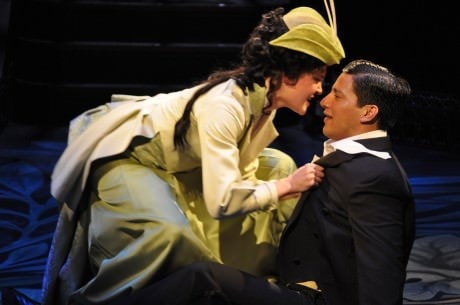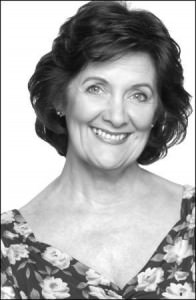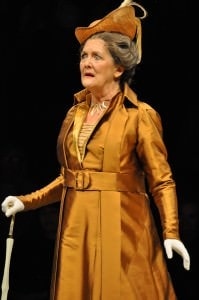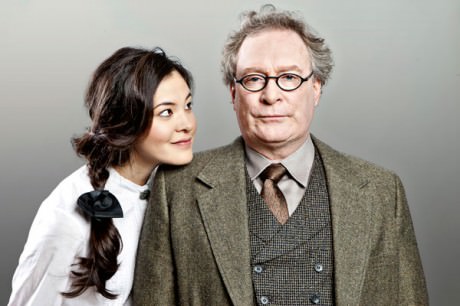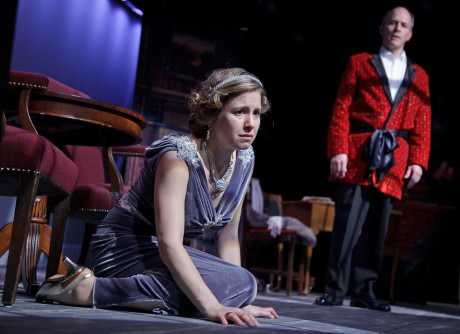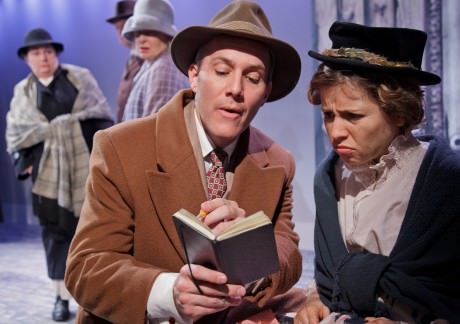Do you have your tide tables? You know: those listings that tell you high tide, low tide, water height, etc. Every newspaper from a city that’s remotely close to water has them, but, unless you’re a fisherman or a sailor, do you ever pay attention to them? Can you even find them?
Well, you’d better. When the world ends, you’re going to need them.

In Conor McPherson’s play The Birds, currently in rehearsal at Quotidian Theatre Company, we’re not exactly at the end of the world, but you’ve got to believe we’re pretty close. Adapted from Daphne du Maurier’s short story, the show is tight, tense, and compelling. I sat in on a run-through last Tuesday, and it made me want to run for my tide tables.
The setting is Ireland in the indeterminate future, but definitely future. Things are (huge understatement here) not going well. Huge populations have been uprooted; people have been roaming from town to town, searching for food, looting other peoples’ homes and occupying them with no regard whatsoever for the owners’ rights — indeed, without any consideration whatsoever for their fellow man. And they’re fleeing the birds, which come in with the tide every six hours or so and attack anyone who happens to be in the open.
But don’t blame it all on the birds. We’re in a real post-apocalyptic scenario, except that there’s no apparent apocalypse. Things just seem to have slid downhill in general, and a good deal of the misery is the result of man’s inhumanity to his fellow man.
The first two characters we see are Diane (Stephanie Mumford), a successful writer in happier days, and Nat (Matthew Vaky), who is tormented by bad dreams and worries about his two children whom he has not seen for almost a year. They are joined by Julia (Jenny Donovan), a young woman who has been hiding from the birds for many days and has seen frightful attacks on fellow refugees. The three begin to cope with life in their new shelter, which leads to inevitable frictions and complications, but also to simple pleasures and celebrations. They are obsessed with the desire to escape their claustrophobic shelter and see if anyone else is alive anywhere, yet they are ever wary of the danger that the birds — and whatever else is lurking — present.
You can see why Hitchcock loved du Maurier’s story: plenty of opportunities for conflict, skullduggery, and just bad business from the marauding birds and from that most unpredictable of creatures, one’s fellow man. But — let’s face it — this territory is well-trodden. End-of-the-world plots have been a staple of countless movies and TV episodes. So what does McPherson offer that keeps this plot from getting bogged down in the tracks? Actually, quite a lot. Philosophy, for one thing. Diane has several monologues that are affecting and powerful as she muses aloud about a killer and her victim, and what the deed does to the mind and soul; the issue of whether the human race was really such a good idea, after all; and the nature and predicament of being God. This is McPherson at his most eloquent.
Also, the script and the production create and sustain a consistent atmosphere of being on the edge. I like this. In the best stories about people in want, everything is close to the bone: Amanda Wingfield keeps her family going on magazine subscriptions and her son Tom’s wages; Linda Loman longs to be free and clear. In The Birds, there is never enough of anything (except temporarily, when unexpected caches of food and alcohol are discovered; but they don’t last); there is constant speculation about whether they can make it to St. Thomas, and whether there will even be anything left when they get there; and, if all that weren’t enough, the birds come back with every tide to menace whoever is left after the frenzied populace have done each other in. This story is not for the faint of heart or the easily depressed, but it is powerful storytelling — and the cast, in case you were wondering, is first-rate.
Even if you don’t know the du Maurier short story of the Hitchcock film, you are bound to come with expectations. Will they turn out to be true? Let’s try out a few:
It’s going to be grim. Well, yeah. What did you expect? This is, after all, the end of the world, or a reasonably good facsimile; show me anybody who has written a cheery script about that. There are just not a lot of chuckles here, with the possible exception of one birthday toast involving a screw-top alcoholic beverage (optimistically identified by Nat as wine) which challenges the imbibers’ most valiant attempts to enjoy it.
There’s going to be violence on stage. Sorry, not in this version. There’s plenty of foreboding, and angst to spare, but nothing awful happens to anyone onstage. As in the classic Greek tragedies, the description of horrors happening elsewhere combines with the audience’s intensely-primed imagination to supply all the realism that’s needed.
People are going to do each other in. That all depends on how you, the audience member, interpret certain things that happen at crucial points in the plot. People die (offstage, of course), but how they died and by whose hand is open to interpretation, surmise, hypothesis. That’s why we have audiences.
So, what is the hardest thing to deal with in this show? For my money, it’s the food — or, rather, the lack of it. Starvation is the unspoken, looming threat. There’s plenty of talk about food, undoubtedly because there’s so little of it; and what there is is far from appetizing, unless you happen to be an aficionado of Spaghetti Hoops and Miwadi Orange. And — remember this — onions are a very important element of the plot, so come prepared to think about where onions occur, and why.
So — last question — Why is Quotidian, of all theatres, doing this piece? Where do realism, naturalism, and the drama of everyday life fit into the desperate, menacing landscape of The Birds? Everywhere, in fact. This is about everyday life — not one that any of us would want, but it is definitely a day-to-day slog. Every mundane chore — making a meal, listening to the radio, going out for a walk — is fraught with difficulty and unintended consequences. Nothing is free of complications. It isn’t pretty — just the opposite — but it is Quotidian. Spend a while in the cramped quarters of this farmhouse, listen to the desperate survivors, feel the gnawing hunger, chafe at the frustrating lack of privacy, and wonder if there is any hope anywhere; and, if there is, is it worth the tremendous risk of setting out to search for it? This is big-league storytelling for serious audiences.
Quotidian Theatre Company’s production of The Birds by Conor McPherson runs July 12th – August 11th. Show times are 8 pm Fridays and Saturdays, 2 pm Sundays, with one additional 2 pm performance on Saturday, August 10th. Tickets are $30, or $25 for seniors and students, and can be purchased online. For groups of 10 or more, contact quotidiantheatre@comcast.net for reservations and $15 tickets. All performances are held at The Writer’s Center – 4508 Walsh Street in Bethesda, MD. The venue is a short walk from the Bethesda Metro Station. There is free parking on Saturdays and Sundays.
The Birds features Jenny Donovan, Stephanie Mumford, Ted Schneider, and Matthew Vaky as directed by Jack Sbarbori. This is the D.C. area premiere.
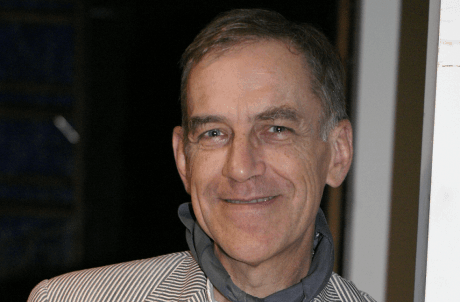
Steve LaRocque has been active in the greater Washington, DC area since 1994 as a performer, director, and playwright. He is a charter member of Quotidian Theatre Company and has appeared in over twenty Quotidian productions; favorite roles include Willis Toome in Horton Foote’s Talking Pictures, Alfred P. Doolittle in Shaw’s Pygmalion, and Lopakhin in Chekhov’s The Cherry Orchard.“He will play the part of Hickey in QTC’s fall production of The Iceman Cometh. LaRocque has also been writing performance pieces of all kinds, from comedy sketches to full-length plays, since 1976, while simultaneously pursuing a 29-year career as a Navy officer, from which he retired in 2005. (He suspects he may be the only playwright to have had a script produced on board a Navy submarine on patrol). Three of his recent scripts have seen productions, all by Quotidian: September 11th was a Tuesday (2003), While We Have the Light (2005), and Monday Evening 1942 (2009). His one-man show Byline: Ernie Pyle is a compilation of the famed WWII war correspondent’s reportage.


